P55 Overclocking Showdown - ASUS, Gigabyte, and EVGA at the OC Corral (Page 6 Updated)
by Rajinder Gill on November 6, 2009 12:00 PM EST- Posted in
- Motherboards
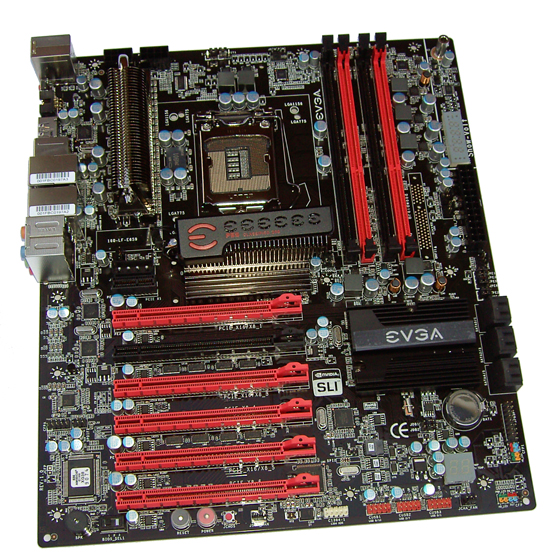

EVGA’s top end offering for P55 is overkill in every single way. Classified specs add a 10-phase Volterra PWM for CPU power, a lower inductance LOTES CPU socket, an onboard digital multi-meter, and an NF200 bridge chip that adds support for triple 16x SLI or CrossFire. Like the P55 FTW E657, version 2 of EVGA’s OCP (overclocking panel) is included giving more than a subtle hint at who this board is designed for.
Priced at $340 or so, this board is more about what EVGA can do than what they should have done for this platform. The existence of X58 fills this segment with a slew of multi-gpu capable boards on the robust and higher performance socket 1366 platform. Nevertheless, we’ve added overclocking results so those who are interested can see how this board fares against others when teamed with the same components and within the same test environment.
Like the E657 model, 7 onboard fan headers are provided with full speed control via BIOS. Due to the addition of the onboard digital multi meter the E659 is classed as E-ATX with dimensions of 304.8mm X 243.8mm (LXW). This might make things a little cramped in smaller PC cases, although we think that anyone choosing a board like this is either going to be someone running an open test bed for benchmarking purposes or is someone who uses a lavish full tower PC case.
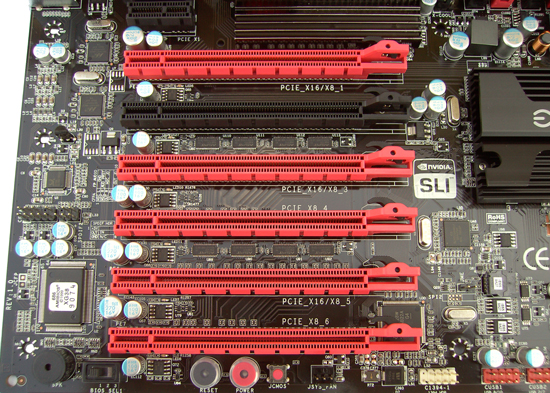
The presence of the NF200 brings a total of six 16x (mechanical) PCI/e slots and one PCI/e x1 slot to the E659. PCI/e X1 at the top, followed by the primary PEG slot running at 16x width in single GPU mode (8x when other PEG slots are occupied).For a full breakdown on lane allocation/link width check the specification table below.
No PCI slots are present on this board, which probably is not a big deal to the intended audience. Slot layout is flexible enough to cater for just about every type of configuration leaving ample upgrade room. We don’t have multi-card performance numbers at this time, although may update later if there is demand to do so.
Underneath the last PCI/e slot, we find power, reset and CMOS clear buttons. A 3 way slider switch is also provided allowing user selection of 3 separate BIOS IC’s. This allows flashing 3 different BIOS files, and also adds a good level of security in the instance of a corrupt BIOS flash. Two USB headers and a IEEE-1394a header are also placed along the bottom edge of the board.
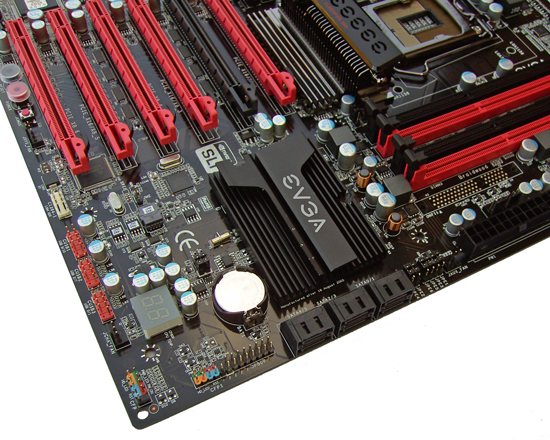
A hex post code display is placed in the lower right corner of the board and over to the left we find 3 BIOS IC’s, one of which is placed within a socket allowing removal if a swap out is required. The CFP1 connector is the EVGA OCP PCB panel connector which allows for on the fly changes 0.1V boost functions to CPU VCore and VTT as well as a post code reader and power, reset and CMOS clear buttons.
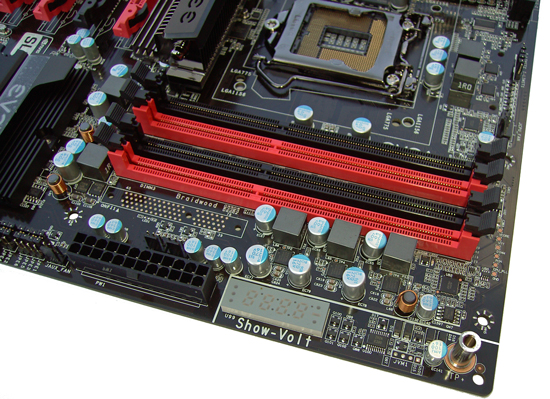
PCI/e disable and X-Cool jumpers are located underneath the DIMM slots. Memory power is supplied by a three phase controller supporting switching speeds up to 640KHz. A test lead is supplied to plug into the positive input socket of the onboard DMM. Test pads for all primary voltage rails are located above the DIMM slots.
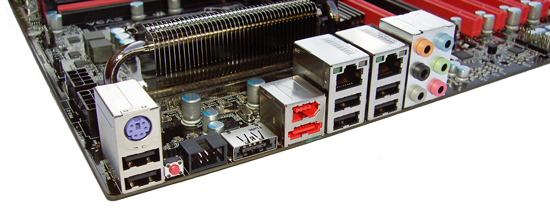
On the rear I/O panel we find 1 x PS2, 7 X USB (1 SATA combo), 1x S/PDIF, 1x Optical, 1 x 1394, 2x RJ45 LAN and 6 audio connectors. A push CMOS reset button is located between the PS2 and S/SPDIF connectors for easy CMOS clear events.
The E657 and E659 models share a practically identical BIOS (refer to screenshots on the E657 page). The only notable changes being the addition of voltage control for the added NF200 on the E659 model, together with an additional compensation adjustment for the CPU.
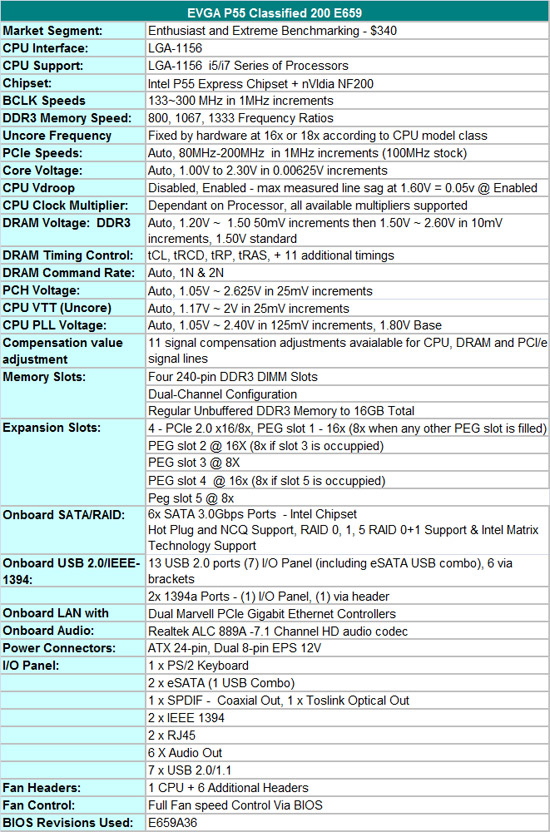










52 Comments
View All Comments
Rajinder Gill - Saturday, November 7, 2009 - link
For max BCLK testingPCI/e speeds were increased (where required) to 115MHz or so (the highest the CPU's I had could run were between 115-118MHz). I tried changes to RTL, memory dividers and all voltages were also changed. Subtiming ranges were shifted out to near maximums to see if that helped and also matched between the best and worst boards in the tests just to make sure something was not creating a hurdle.regards
Raja
dingetje - Friday, November 6, 2009 - link
wow the p55 platform is totally screwd if this problem persists...any overclocker still oc'ing the hell out of their p55 must be either brave, rich or (michael jackson voice on:) ignoraaaantdingetje - Friday, November 6, 2009 - link
oops, this was supposed to be a comment, not a reply...damn UI :Pdingetje - Friday, November 6, 2009 - link
now if we could only edit our posts I would so happypetergab - Friday, November 6, 2009 - link
What about any MSI boards? I know they may not count to the "extreme" OC but I think they should have a representative in such reviews.Rajinder Gill - Friday, November 6, 2009 - link
The MSI board was due to be included but left out becasue of CPU damage that occurred during the socket burnouts. This left no real way of cross comparing the prior results with the MSI boards abilities on the same CPU. At that point I decided to run with what I had at the time rather than starting afresh thus delaying the article even further.regards
Raja
spiderbutt - Friday, November 6, 2009 - link
Are you planning to include the MSI boards at a later date? I am curious to see how they compare to the other boards.Thanks for your hard work Raja it is appreciated!
Rajinder Gill - Friday, November 6, 2009 - link
Hi,There will be some MSI P55 board reviews coming, although those were planned in more typical usage scenarios. I guess what I can do is use a different CPU in the E657 EVGA board for cross compare to any high-end P55 MSI offering we review to see how things stack up.
regards
Raja
1stguess - Friday, November 6, 2009 - link
Wow. This is a bold article. Does anyone dare OC their P55 setup? Madness.jav6454 - Friday, November 6, 2009 - link
I've been looking at these P55 boards and somehow I always thought high of the EVGA. However these results have proven my gut feeling right.Bad thing of the EVGA boards is sometimes their higher price tag.